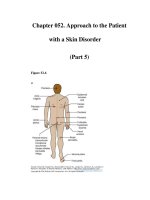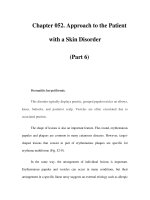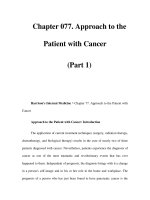Chapter 077. Approach to the Patient with Cancer (Part 5) doc
Bạn đang xem bản rút gọn của tài liệu. Xem và tải ngay bản đầy đủ của tài liệu tại đây (14.36 KB, 5 trang )
Chapter 077. Approach to the
Patient with Cancer
(Part 5)
Making a Treatment Plan
From information on the extent of disease and the prognosis and in
conjunction with the patient's wishes, it is determined whether the treatment
approach should be curative or palliative in intent. Cooperation among the various
professionals involved in cancer treatment is of the utmost importance in treatment
planning. For some cancers, chemotherapy or chemotherapy plus radiation therapy
delivered before the use of definitive surgical treatment (so-called neoadjuvant
therapy) may improve the outcome, as seems to be the case for locally advanced
breast cancer and head and neck cancers. In certain settings in which combined
modality therapy is intended, coordination among the medical oncologist,
radiation oncologist, and surgeon is crucial to achieving optimal results.
Sometimes the chemotherapy and radiation therapy need to be delivered
sequentially, and other times concurrently. Surgical procedures may precede or
follow other treatment approaches. It is best for the treatment plan either to follow
a standard protocol precisely or else to be part of an ongoing clinical research
protocol evaluating new treatments. Ad hoc modifications of standard protocols
are likely to compromise treatment results.
The choice of treatment approaches was formerly dominated by the local
culture in both the university and the practice settings. However, it is now possible
to gain access electronically to standard treatment protocols and to every approved
clinical research study in North America through a personal computer interface
with the Internet.
2
The skilled physician also has much to offer the patient for whom curative
therapy is no longer an option. Often a combination of guilt and frustration over
the inability to cure the patient and the pressure of a busy schedule greatly limit
the time a physician spends with a patient who is receiving only palliative care.
Resist these forces. In addition to the medicines administered to alleviate
symptoms (see below), it is important to remember the comfort that is provided by
holding the patient's hand, continuing regular examinations, and taking time to
talk.
2
The National Cancer Institute maintains a database called PDQ (Physician
Data Query) that is accessible on the Internet under the name CancerNet at
Information can be obtained through a
facsimile machine using CancerFax by dialing 301-402-5874. Patient information
is also provided by the National Cancer Institute in at least three formats: on the
Internet via CancerNet at through the
CancerFax number listed above, or by calling 1-800-4-CANCER. The quality
control for the information provided through these services is rigorous.
Management of Disease and Treatment Complications
Because cancer therapies are toxic (Chap. 81), patient management
involves addressing complications of both the disease and its treatment as well as
the complex psychosocial problems associated with cancer. In the short term
during a course of curative therapy, the patient's functional status may decline.
Treatment-induced toxicity is less acceptable if the goal of therapy is palliation.
The most common side effects of treatment are nausea and vomiting (see below),
febrile neutropenia (Chap. 82), and myelosuppression (Chap. 81). Tools are now
available to minimize the acute toxicity of cancer treatment.
New symptoms developing in the course of cancer treatment should always
be assumed to be reversible until proven otherwise. The fatalistic attribution of
anorexia, weight loss, and jaundice to recurrent or progressive tumor could result
in a patient dying from a reversible intercurrent cholecystitis. Intestinal obstruction
may be due to reversible adhesions rather than progressive tumor. Systemic
infections, sometimes with unusual pathogens, may be a consequence of the
immunosuppression associated with cancer therapy. Some drugs used to treat
cancer or its complications (e.g., nausea) may produce central nervous system
symptoms that look like metastatic disease or may mimic paraneoplastic
syndromes such as the syndrome of inappropriate antidiuretic hormone. A
definitive diagnosis should be pursued and may even require a repeat biopsy.
A critical component of cancer management is assessing the response to
treatment. In addition to a careful physical examination in which all sites of
disease are physically measured and recorded in a flow chart by date, response
assessment usually requires periodic repeating of imaging tests that were abnormal
at the time of staging. If imaging tests have become normal, repeat biopsy of
previously involved tissue is performed to document complete response by
pathologic criteria. Biopsies are not usually required if there is macroscopic
residual disease. A complete response is defined as disappearance of all evidence
of disease, and a partial response as >50% reduction in the sum of the products of
the perpendicular diameters of all measurable lesions. The determination of partial
response may also be based on a 30% decrease in the sums of the longest
diameters of lesions (Response Evaluation Criteria in Solid Tumors, or RECIST,
criteria). Progressive disease is defined as the appearance of any new lesion or an
increase of >25% in the sum of the products of the perpendicular diameters of all
measurable lesions (or an increase of 20% in the sums of the longest diameters by
RECIST). Tumor shrinkage or growth that does not meet any of these criteria is
considered stable disease. Some sites of involvement (e.g., bone) or patterns of
involvement (e.g., lymphangitic lung or diffuse pulmonary infiltrates) are
considered unmeasurable. No response is complete without biopsy documentation
of their resolution, but partial responses may exclude their assessment unless clear
objective progression has occurred.









